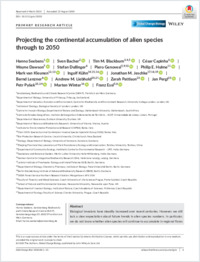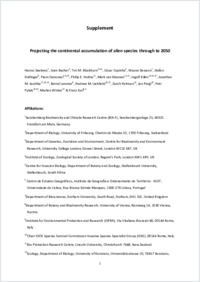Projecting the continental accumulation of alien species through to 2050
- Seebens, Hanno Senckenberg Biodiversity and Climate Research Centre (SBi, K‐F) Frankfurt am Main Germany
- Bacher, Sven Department of Biology University of Fribourg Fribourg Switzerland
- Blackburn, Tim M. Department of Genetics, Evolution and Environment Centre for Biodiversity and Environment Research University College London London UK - Institute of Zoology Zoological Society of London London UK - Centre for Invasion Biology Department of Botany and Zoology Stellenbosch University Stellenbosch South Africa
- Capinha, César Centro de Estudos Geográficos Instituto de Geografia e Ordenamento do Território – IGOTUniversidade de Lisboa Lisbon Portugal
- Dawson, Wayne Department of Biosciences Durham University Durham UK
- Dullinger, Stefan Department of Botany and Biodiversity Research University of Vienna Vienna Austria
- Genovesi, Piero Centre for Invasion Biology Department of Botany and Zoology Stellenbosch University Stellenbosch South Africa - Institute for Environmental Protection and Research (ISPRA) Rome Italy - Chair IUCN Species Survival Commission Invasive Species Specialist Group (ISSG) Rome Italy
- Hulme, Philip E. Bio‐Protection Research Centre Lincoln University Christchurch New Zealand
- Kleunen, Mark Ecology Department of Biology University of Konstanz Konstanz Germany - Zhejiang Provincial Key Laboratory of Plant Evolutionary Ecology and Conservation Taizhou University Taizhou China
- Kühn, Ingolf Department of Community Ecology Helmholtz Centre for Environmental Research – UFZ Halle Germany - Geobotany and Botanical Garden Martin Luther University Halle‐Wittenberg Halle Germany - German Centre for Integrative Biodiversity Research (i, Div) Halle‐Jena‐Leipzig Leipzig Germany
- Jeschke, Jonathan M. Leibniz‐Institute of Freshwater Ecology and Inland Fisheries (IGB) Berlin Germany - Department of Biology, Chemistry, Pharmacy Institute of Biology Freie Universität Berlin Berlin Germany - Berlin‐Brandenburg Institute of Advanced Biodiversity Research (BBIB) Berlin Germany
- Lenzner, Bernd Department of Botany and Biodiversity Research University of Vienna Vienna Austria
- Liebhold, Andrew M. USDA Forest Service Northern Research Station Morgantown WV USA - Faculty of Forestry and Wood Sciences Czech University of Life Sciences Prague Praha‐Suchdol Czech Republic
- Pattison, Zarah School of Natural and Environmental Sciences Newcastle University Newcastle upon Tyne UK
- Pergl, Jan Department of Invasion Ecology Institute of Botany Czech Academy of Sciences Průhonice Czech Republic
- Pyšek, Petr Department of Invasion Ecology Institute of Botany Czech Academy of Sciences Průhonice Czech Republic - Department of Ecology Faculty of Science Charles University Prague Czech Republic
- Winter, Marten German Centre for Integrative Biodiversity Research (i, Div) Halle‐Jena‐Leipzig Leipzig Germany
- Essl, Franz Centre for Invasion Biology Department of Botany and Zoology Stellenbosch University Stellenbosch South Africa - Department of Botany and Biodiversity Research University of Vienna Vienna Austria
-
01.10.2020
Published in:
- Global Change Biology. - 2020, p. gcb.15333
English
Biological invasions have steadily increased over recent centuries. However, we still lack a clear expectation about future trends in alien species numbers. In particular, we do not know whether alien species will continue to accumulate in regional floras and faunas, or whether the pace of accumulation will decrease due to the depletion of native source pools. Here, we apply a new model to simulate future numbers of alien species based on estimated sizes of source pools and dynamics of historical invasions, assuming a continuation of processes in the future as observed in the past (a business‐as‐usual scenario). We first validated performance of different model versions by conducting a back‐casting approach, therefore fitting the model to alien species numbers until 1950 and validating predictions on trends from 1950 to 2005. In a second step, we selected the best performing model that provided the most robust predictions to project trajectories of alien species numbers until 2050. Altogether, this resulted in 3,790 stochastic simulation runs for 38 taxon–continent combinations. We provide the first quantitative projections of future trajectories of alien species numbers for seven major taxonomic groups in eight continents, accounting for variation in sampling intensity and uncertainty in projections. Overall, established alien species numbers per continent were predicted to increase from 2005 to 2050 by 36%. Particularly, strong increases were projected for Europe in absolute (+2,543 ± 237 alien species) and relative terms, followed by Temperate Asia (+1,597 ± 197), Northern America (1,484 ± 74) and Southern America (1,391 ± 258). Among individual taxonomic groups, especially strong increases were projected for invertebrates globally. Declining (but still positive) rates were projected only for Australasia. Our projections provide a first baseline for the assessment of future developments of biological invasions, which will help to inform policies to contain the spread of alien species.
- Faculty
- Faculté des sciences et de médecine
- Department
- Département de Biologie
- Language
-
- English
- Classification
- Biological sciences
- License
- License undefined
- Identifiers
-
- RERO DOC 329611
- DOI 10.1111/gcb.15333
- Persistent URL
- https://folia.unifr.ch/unifr/documents/308925
Other files
Statistics
Document views: 154
File downloads:
- bac_pca.pdf: 161
- bac_pca_sm.pdf: 126

